
Emerald is a gemstone and a variety of the mineral beryl (Be3Al2(SiO3)6) colored green by trace amounts of chromium or sometimes vanadium. Beryl has a hardness of 7.5–8 on the Mohs scale. Most emeralds have many inclusions, so their toughness (resistance to breakage) is classified as generally poor. Emerald is a cyclosilicate.
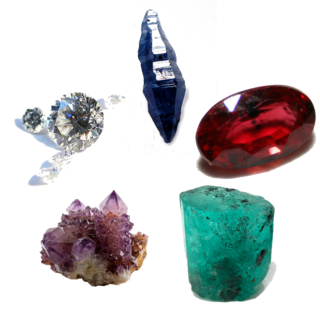
A gemstone is a piece of mineral crystal which, when cut or polished, is used to make jewelry or other adornments. Certain rocks and occasionally organic materials that are not minerals may also be used for jewelry and are therefore often considered to be gemstones as well. Most gemstones are hard, but some softer minerals such as brazilianite may be used in jewelry because of their color or luster or other physical properties that have aesthetic value. However, generally speaking, soft minerals are not typically used as gemstones by virtue of their brittleness and lack of durability.
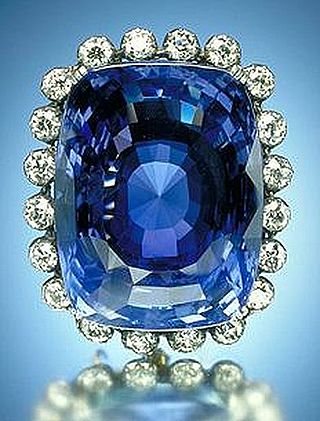
Sapphire is a precious gemstone, a variety of the mineral corundum, consisting of aluminium oxide (α-Al2O3) with trace amounts of elements such as iron, titanium, cobalt, lead, chromium, vanadium, magnesium, boron, and silicon. The name sapphire is derived from the Latin word sapphirus, itself from the Greek word sappheiros (σάπφειρος), which referred to lapis lazuli. It is typically blue, but natural "fancy" sapphires also occur in yellow, purple, orange, and green colors; "parti sapphires" show two or more colors. Red corundum stones also occur, but are called rubies rather than sapphires. Pink-colored corundum may be classified either as ruby or sapphire depending on the locale. Commonly, natural sapphires are cut and polished into gemstones and worn in jewelry. They also may be created synthetically in laboratories for industrial or decorative purposes in large crystal boules. Because of the remarkable hardness of sapphires – 9 on the Mohs scale (the third hardest mineral, after diamond at 10 and moissanite at 9.5) – sapphires are also used in some non-ornamental applications, such as infrared optical components, high-durability windows, wristwatch crystals and movement bearings, and very thin electronic wafers, which are used as the insulating substrates of special-purpose solid-state electronics such as integrated circuits and GaN-based blue LEDs. Sapphire is the birthstone for September and the gem of the 45th anniversary. A sapphire jubilee occurs after 65 years.
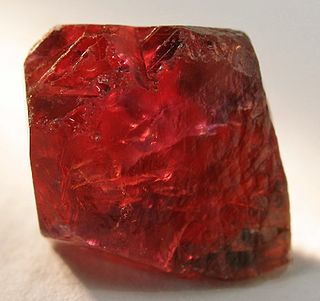
Ruby is a pinkish red to blood-red colored gemstone, a variety of the mineral corundum. Ruby is one of the most popular traditional jewelry gems and is very durable. Other varieties of gem-quality corundum are called sapphires. Ruby is one of the traditional cardinal gems, alongside amethyst, sapphire, emerald, and diamond. The word ruby comes from ruber, Latin for red. The color of a ruby is due to the element chromium.
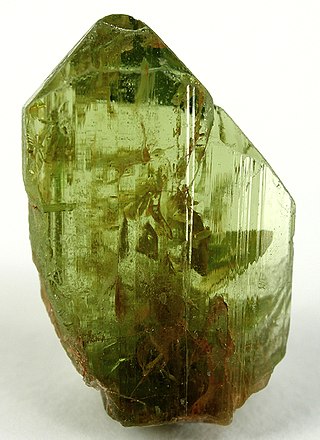
Peridot, sometimes called chrysolite, is a yellow-green transparent variety of olivine. Peridot is one of the few gemstones that occur in only one color.
Lustre or luster is the way light interacts with the surface of a crystal, rock, or mineral. The word traces its origins back to the Latin lux, meaning "light", and generally implies radiance, gloss, or brilliance.
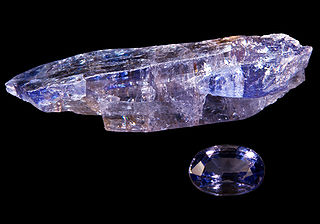
Tanzanite is the blue and violet variety of the mineral zoisite, caused by small amounts of vanadium. Tanzanite belongs to the epidote mineral group. Tanzanite is only found in Simanjiro District of Manyara Region in Tanzania, in a very small mining area approximately 7 km (4.3 mi) long and 2 km (1.2 mi) wide near the Mererani Hills.
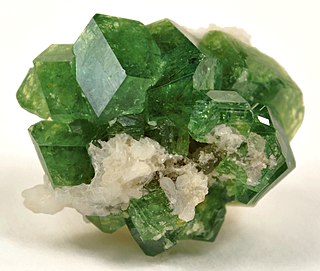
Demantoid is the green gemstone variety of the mineral andradite, a member of the garnet group of minerals. Andradite is a calcium- and iron-rich garnet. The chemical formula is Ca3Fe2(SiO4)3 with chromium substitution as the cause of the demantoid green color. Ferric iron is the cause of the yellow in the stone.

The Gemological Institute of America (GIA) is a nonprofit institute based in Carlsbad, California. It is dedicated to research and education in the field of gemology and the jewelry arts. Founded in 1931, GIA's mission is to protect buyers and sellers of gemstones by setting and maintaining the standards used to evaluate gemstone quality. The institute does so through research, gem identification, diamond grading services, and a variety of educational programs. Through its library and subject experts, GIA acts as a resource of gem and jewelry information for the trade, the public and media outlets.

Tairus is a synthetic gemstone manufacturer. It was formed in 1989 as part of Mikhail Gorbachev's perestroika initiative to establish a joint venture between the Russian Academy of Sciences and Tairus Created Gems Co Ltd. of Bangkok, Thailand. Today Tairus is a major supplier of hydrothermally grown gemstones to the jewellery industry. Later, Tairus became a privately held enterprise, operating out of its Bangkok distribution hub under the trade name Tairus, owned by Tairus Created Gems Co Ltd. of Bangkok, Thailand.
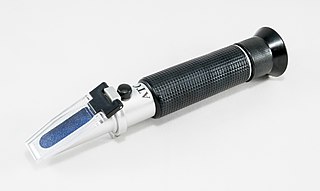
A refractometer is a laboratory or field device for the measurement of an index of refraction (refractometry). The index of refraction is calculated from the observed refraction angle using Snell's law. For mixtures, the index of refraction then allows the concentration to be determined using mixing rules such as the Gladstone–Dale relation and Lorentz–Lorenz equation.
In gemmology, a Chelsea filter is a dichromatic optical filter used for identifying coloured stones.
The Asian Institute of Gemological Sciences (AIGS) is a private gemological school and gemological laboratory based in Bangkok, Thailand.
Gemmological Institute of India is a gemmology training school in Mumbai, India.
The Swiss Gemmological Institute (SSEF) is a gemmology laboratory located in Basel, Switzerland. It is a part of the Schweizerische Stiftung für Edelstein Forschung. It was founded on an independent basis, by trade organisations, on August 22, 1972. George Bosshart, mineralogist and GG was the first director after the laboratory's opening in Zürich. Diamond grading was the major task and colour stones were tested rather exceptionally. In 1980 Bosshart hired Dr. Henry A. Hänni, Mineralogist and FGA. In 1994 Hänni moved the laboratory to Basel. He has been teaching gemmology at Basel university, and the close link to the university proved to be very enriching for both parts, academic and laboratory work. Hänni became professor of gemmology at Basel University, also a reward for his years of steady research and supply of publications. Prof. H.A. Hänni retired in 2009 and Dr. Michael Krzemnicki took over his position as a director. Dr. Krzemnicki has been working for SSEF since 1999.
Richard T. Liddicoat, Jr. was an American gemologist. An educator in gemology, he contributed in the area of diamond quality grading and gem identification. Liddicoat was the Chairman of the Board of Governors at the Gemological Institute of America (GIA).

Richard W. Hughes is an American gemologist and author, known as an authority on corundum, rubies and sapphires.
The German Gemmological Association (DGemG) is a nonprofit, technical-scientific association in the field of gemmology, located in the European gemstone center Idar-Oberstein. The two most important points of the statutes are the promotion of gemmology as science and technique and the development of information and education in the field of gemmology.
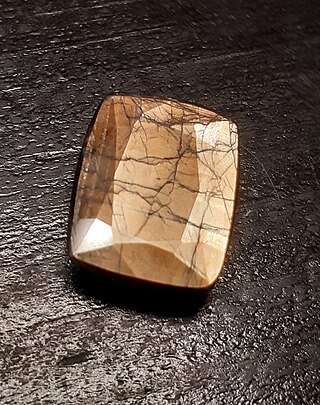
Golden sheen sapphire, is a recently discovered variety of corundum. Goldsheen sapphire has been tested and confirmed in lab reports as "natural sapphire" by GIA, GIT, GRS, AIGS, Tokio gem labs and Lotus.
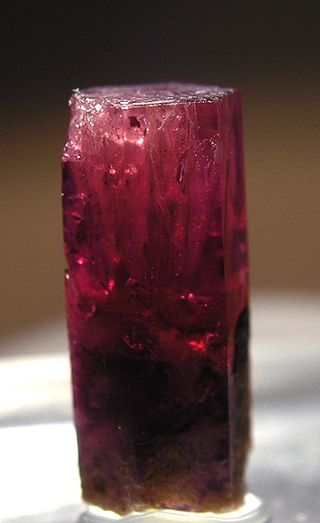
Red beryl, formerly known as bixbite and marketed as red emerald or scarlet emerald, is an extremely rare variety of beryl as well as one of the rarest minerals on Earth. The gem gets its red color from manganese ions embedded inside of beryllium aluminium cyclosilicate crystals. The color of red beryl is stable up to 1,000 °C (1,830 °F). Red beryl can come in various tints like strawberry, bright ruby, cherry, and orange.


















